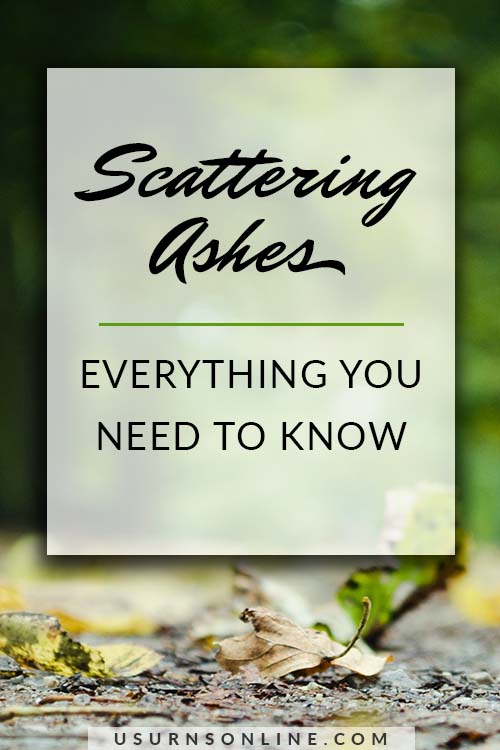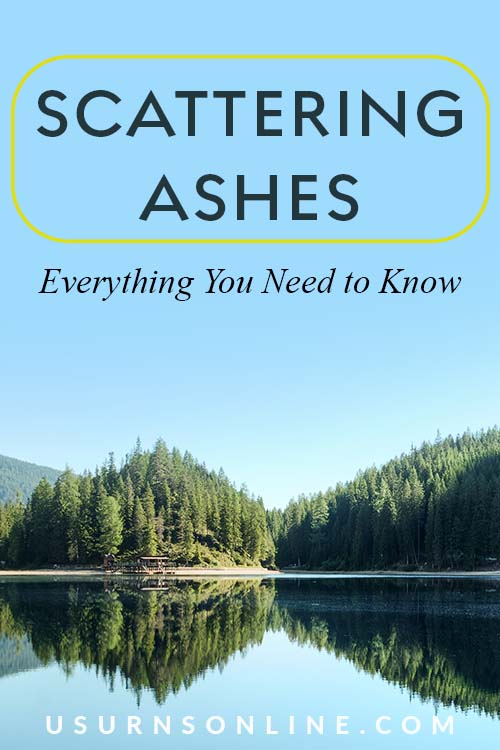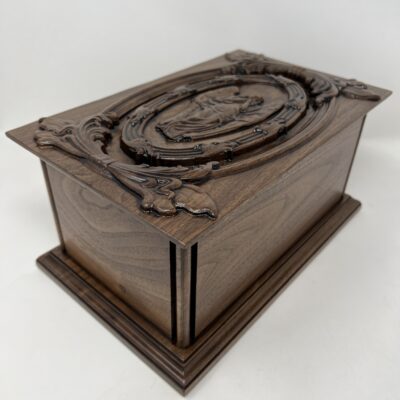Scattering ashes is increasingly becoming the favored choice for a loved one’s final disposition.
In part, this is because cremation is much simpler, cheaper, and provides more creative options than a traditional cemetery burial. But then the question becomes, what do you do with the ashes?
Well, most families either place the remains in a cremation urn and bury (in a smaller, more affordable plot), place in a columbarium niche, or keep the urn at home. But a fourth option – scattering – is one of the most romantic, free-spirited, and memorable.
Below, you’ll learn where, why, and how to scatter cremated remains.
How to Scatter Ashes
The act of scattering is very simple. Hold the container about waist high, with your back to the wind and any family members or friends behind you. Tip the container and begin scattering.
To do this well and in a respectful, appropriate way, you’ll need to prepare four things.
- Scattering urn or suitable container
- Location (with permission) to scatter
- Method for scattering
- What to say before and after
1. Choose a Scattering Urn or Container
The first thing is to choose the scattering urn or container you’ll use to pour out the remains. This can really be a simple or as creatively unique as you like. All you need is something that will hold all the ashes, and that will also make pouring out the remains as easy as possible.
Use the temporary urn you received from the crematorium, or purchase an attractive scattering urn designed to make the process simple. You can also make your own using things you may already have around the house.
2. Choose the Location & Get Permission
We’ll talk more about the location below, but for now, here’s the main point: You need permission.
If you’re scattering on your own property, go right ahead. For any other private or public land, you’ll need to get permission from the person who owns the property.
Urns Made in the USA
Scattering is permitted in most National Parks. State, county, or city parks will likely require permission.
3. Choose a Scattering Method
There are a few creative ways to go about the actual process of scattering. Let’s take a look.
Traditional Casting or Pouring
When you think about scattering, this is the method that likely comes to mind. As mentioned above, hold out the scattering urn, make sure the wind is blowing away from you, and pour.
Trenching
Here is a scattering method that invites participation, ideal for locations like the beach. Dig one or more small trenches several feet in length. Pour the ashes into it along the length of the trench.
Once the service is completed, you and your loved ones can spread the earth or sand back over the trench using hands, small shovels, or rakes. This method disperses the ashes into the earth in a way that is respectful and contained.
Raking
Pour our the remains over an area of loose dirt, freshly tilled earth, or sand. Family members and friends can take turns slowly raking the remains into the ground, returning the loved one back to the earth. Ideal for gardens.
Water Scattering
Scattering in water can be done two ways, either by the typical pouring method or by using a specially designed biodegradable water scattering urn.
For the first method, whether from a boat, on a pier, near the shore, or along the edge of a river, simply pour the remains out into the water.
The second method is ideal for when you don’t want to pour out the remains, but still want your loved one’s ashes scattered at sea. These biodegradable ocean scattering urns are made to be placed into the water, float briefly, then sink to the ocean floor to slowly release and scatter your loved one’s remains.
Click here to learn more about burial at sea.
Raise a Glass
Fill toasting glasses with ashes and provide one for each family member. Give a toast, raise a glass in memory of your loved one, then let everyone scatter as they see fit.
More Ideas
Find additional creative and unique ideas here, including shooting the ashes in bullets or as fireworks, launched into space, and much more.
4. Plan What to Say
Thankfully, scattering ceremonies are a lot more casual than a funeral, memorial service, or life celebration. So you won’t be planning another service.
Still, you want it to be meaningful. And you certainly don’t want it to be awkward or weird. So it’s smart to think about what to say before and after.
We’ve put together an entire article on what to say when scattering ashes. The main point is to think of something to say before, something to say after, and keep it simple.
Share a story about your loved one, or a favorite quote or Scripture verse. Close with a prayer, blessing, or farewell. That’s all you really need to do. You can do more or less, but it’s important to think about beforehand.
Where to Scatter Ashes
Here are some favorite options. Remember, because you can divide the remains, you don’t need to limit yourself to just one location.
- A location with personal significance
- Family cemetery plot
- Backyard
- Garden
- Church
- Hiking trail
- Bike path
- Waterfall
- River
- Lake
- Beach
- Ocean
- Mountain
- Sports field
- Park
- Airplane, helicopter, or balloon
If you scatter in any public area, such as a park or along a hiking path, make sure to do the scattering away from where people tend to walk or congregate.
Why Scattering?
For some people, the main question is why. Why should we scatter? Is it better or more meaningful than any other method?
Ultimately, you’ll have to answer that question for yourself. But here are a few considerations.
Scattering is affordable. There’s no cost to it, unless you charter a boat or plane or add any other fancy elements. You simply pour out the remains. You don’t need to pay for a cemetery plot or columbarium niche or a casket or anything else.
Scattering is simple. At least, it’s a simple as you want it to be. Now, it might take a little doing to arrange everyone to gather at one place, or that one special location might take some work to obtain permission. Those quirks aside, you just show up, gather around, and scatter.
Scattering is meaningful. Perhaps it’s the location that means a lot. Your family property, the beach where you proposed, a favorite hilltop view. Or maybe it’s the act of releasing your free-spirited loved one’s remains into the wild, or returning your hard-working farmer husband back to the earth he so loved. Sure, some people might find meaning and comfort in a traditional funeral, but for your loved one, if scattering feels right, you’ll know it. And you’ll know why.
Does scattering ashes help with grief?
The last wishes of our lost loved ones are sacred. This is why our final obligations, our final acts, for those who have died are the most profound, perhaps the most important, of our lives.
For some, having a physical space to mourn is essential to the grieving process. They may find comfort in being able to visit the grave of a loved one, in having a designated space to reflect, pray, and celebrate good news and to share bad news with the one who has died.
The act of scattering is an act of letting go. Now, you still may have a space to go – a flower garden, a favorite field or nature trail – but sometimes the decedent asks to be scattered way off in the wilderness or someplace out at sea.
For some mourners, the “letting go” aspect of scattering may be extremely difficult. For others, it may be the moment they come to acceptance.
Will scattering help with grief? We can’t say for your personal grief journey, but we can tell you that there is a sense of satisfaction and accomplishment to be had in carrying out your loved one’s final wishes. And that may just be enough to provide some comfort.
Can I remove ashes from the urn to be scattered?
Most of our regular wood urns open by removing the base, which is really easy to do. The base or bottom panel is attached using four to six standard screws, simply flip the urn upside-down, remove the screws, and you’re ready to remove the ashes. (You can watch a video demo here.)
Normally, when the funeral home places the remains inside the urn box, the ashes will already be sealed inside of the plastic bag in which they come.
To remove the ashes from an urn to be scattered, all you need to do is take off the bottom panel or base and pull out the plastic bag. You can scatter straight from the plastic bag, or if you prefer you can get a simple scattering container like one of these scattering urns.
How do you make scattering meaningful?
When you scatter the ashes of your loved one, though, it may feel as though you are losing that tenuous bit of connection. This can magnify an already heartrending loss. And yet there are ways to cope with and even find comfort in this ritual.
Many mourners, for example, choose not to scatter their loved one’s ashes all at once or in a single place. Instead, they select several of the most meaningful and memorable spots, commemorating their loved one by retracing his or her happiest moments.
And in this way, the process of letting go of the loved one’s remains is also a process of retelling—and celebrating—his or her life story. It is a gradual letting go, but it is also a way of bringing the loved one even closer.
Because instead of confining him to a single place with which he may have had no real connection in life, a place defined only by sadness and loss, you are instead reuniting him with those spaces where he was happiest and most alive.
You are infusing the sky, the land, the sea, with the remains of the one you love. You are transforming those spaces dear to your dear one into sacred territory. For many, there is no more profound way to honor a loved one’s memory.
Read Next: 25 Weird Questions About Cremation That People Always Ask
Pin It






If ashes are scattered on private land and the land is then sold, do you have to disclose the presence of the deceased? In Oregon.
No, you do not have to disclose ash scattering.